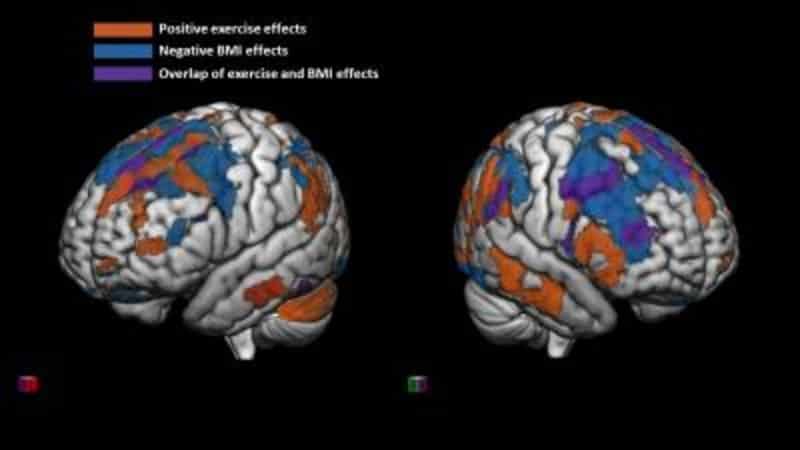Summary: Children who embark on regular exercise have marked differences in brain structure, flexibility, organization, and have more robust neural networks than those who exercise less frequently.
Source: Boston Children’s Hospital
Regular physical activity has positive effects on children’s developing brain circuits, finds a Boston Children’s Hospital study using neuroimaging data from nearly 6,000 early adolescents. Physical activity of any kind was associated with more efficiently organized, flexible, and robust brain networks, the researchers found. The more physical activity, the more “fit” the brain.
Findings were published in Cerebral Cortex on May 14.
“It didn’t matter what kind of physical activity children were involved in – it only mattered that they were active,” says Caterina Stamoulis, PhD, principal investigator on the study and director of the Computational Neuroscience Laboratory at Boston Children’s. “Being active multiple times per week for at least 60 minutes had a widespread positive effect on brain circuitry.”
Specifically, Stamoulis and her trainees, Skylar Brooks and Sean Parks, found positive effects on circuits in multiple brain areas. These circuits play a fundamental role in cognitive function and support attention, sensory processing, motor function, memory, decision-making, and executive control. Regular physical activity also partially offset the effects of unhealthy body mass index (BMI), which was associated with detrimental effects on the same brain circuitry.
Harnessing big data
With support from the National Science Foundation’s Harnessing the Data Revolution and BRAIN Initiative, the researchers tapped data from the long-term, NIH-sponsored Adolescent Brain Cognitive Development (ABCD) study. They analyzed functional magnetic resonance imaging (fMRI) data from 5,955 9- and 10-year-olds and crunched these data against data on physical activity and BMI, using advanced computational techniques developed in collaboration with the Harvard Medical School High Performance Computing Cluster.
“Early adolescence is a very important time in brain development,” notes Stamoulis. “It’s associated with a lot of changes in the brain’s functional circuits, particularly those supporting higher-level processes like decision-making and executive control. Abnormal changes in these areas can lead to risk behaviors and deficits in cognitive function that can follow people throughout their lifetime.”
Gauging functional brain organization
The functional MRI data were captured in the resting state, when the children were not performing any explicit cognitive task. This allows analysis of the “connectome” — the architecture of brain connections that determines how efficiently the brain functions and how readily it can adapt to changes in the environment, independently of specific tasks.
The team adjusted the data for age, gestational age at birth, puberty status, sex, race, and family income. Physical activity and sports involvement measures were based on youth and parent surveys collected by the ABCD study.

The analysis found that physical activity was associated with positive brain-wide network properties reflecting the connectome’s efficiency, robustness, and clustering into communities of brain regions. These same properties were detrimentally affected by high BMI. Physical activity also had a positive effect on local organization of the brain; unhealthy BMI had adverse impacts in some of the same areas.
“Based on our results, we think physical activity affects brain organization directly, but also indirectly by reducing BMI, therefore mitigating its negative effects,” Stamoulis says.
Optimal functional brain structure consists of small regions or “nodes” that are well connected internally and send information to other parts of the brain through strong, but relatively few, long-range connections, Stamoulis explains.
“This organization optimizes the efficiency of information processing and transmission, which is still developing in adolescence and can be altered by a number of risk factors,” she says. “Our results suggest that physical activity has a protective effect on this optimization process across brain regions.”
Skylar Brooks was first author on the paper.
Funding: The study was funded by the National Science Foundation (grant nos. 1940094 and 1649865).
About this neurodevelopment and exercise research news
Source: Boston Children’s Hospital
Contact: Bethany Tripp – Boston Children’s Hospital
Image: The image is credited to Skylar Brooks, Computational Neuroscience Laboratory, Boston Children’s Hospital
Original Research: Closed access.
“Widespread Positive Direct and Indirect Effects of Regular Physical Activity on the Developing Functional Connectome in Early Adolescence” by Skylar Brooks et al. Cerebral Cortex
Abstract
Widespread Positive Direct and Indirect Effects of Regular Physical Activity on the Developing Functional Connectome in Early Adolescence
Adolescence is a period of profound but incompletely understood changes in the brain’s neural circuitry (the connectome), which is vulnerable to risk factors such as unhealthy weight, but may be protected by positive factors such as regular physical activity.
In 5955 children (median age = 120 months; 50.86% females) from the Adolescent Brain Cognitive Development (ABCD) cohort, we investigated direct and indirect (through impact on body mass index [BMI]) effects of physical activity on resting-state networks, the backbone of the functional connectome that ubiquitously affects cognitive function.
We estimated significant positive effects of regular physical activity on network connectivity, efficiency, robustness and stability (P ≤ 0.01), and on local topologies of attention, somatomotor, frontoparietal, limbic, and default-mode networks (P < 0.05), which support extensive processes, from memory and executive control to emotional processing.
In contrast, we estimated widespread negative BMI effects in the same network properties and brain regions (P < 0.05). Additional mediation analyses suggested that physical activity could also modulate network topologies leading to better control of food intake, appetite and satiety, and ultimately lower BMI.
Thus, regular physical activity may have extensive positive effects on the development of the functional connectome, and may be critical for improving the detrimental effects of unhealthy weight on cognitive health.






